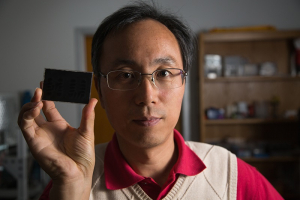In 2010 graphene took center stage when the Nobel Prize in Physics was awarded to two scientists in the UK "for groundbreaking experiments regarding the two-dimensional material graphene." At the UH Cullen College of Engineering, that same passion over pencil lead is shared by Jiming Bao, associate professor of electrical and computer engineering, but he’s taken it to a whole new dimension, with a patent filed on his process to rotate and align graphene flakes in 3D by using a magnetic field. You can read about it in the latest issue of the journal Advanced Materials.
“It’s a breakthrough,” said Bao. “No one has ever thought to rotate and align graphene or the magnetic properties of graphene. It’s so strong. No one thought it could be rotated by a tiny magnet.”
Editors at Advanced Materials must have agreed, Bao said, noting the unusually short time it took for his article to be accepted for publication.
“Sometimes it takes six months to get an article published. They accepted this one in two weeks,” Bao said.
For the uninitiated, graphene is made of carbon, just like graphite (the lead in pencils) and diamonds (the beautiful treasures that sparkle in your jewelry). Though all are made of the same stuff, the atoms are arranged differently in each.
Scientists seem to gush over graphene, touting it as one of the lightest, strongest conductors of heat and electricity. According to Bao, it could make computers faster, microwave ovens safer and everything much cheaper.
“It’s much cheaper than metal to produce and opens enormous application possibilities,” said Bao. “Graphene is very conductive, even more conductive than copper,” he said. It can replace copper wire or the magnetic shield in front of the microwave. It can also dissipate heat much faster than the commonly-used materials of today. It is a diamagnetic material, meaning it can create a magnetic field and, at the same time, oppose one.
If you’re keeping score, that means graphene will be another material (like a superconductor) that will make things, like trains, levitate. At extremely low temperatures, superconductors allow current to flow without resistance and repel a magnet, but with more strength, a superconductor and magnet will repel against gravity, causing stable magnetic levitation.
In Bao’s experiments he found that aligning the graphene flakes makes them powerful. “When graphene flakes are assembled in the same planar direction, they show excellent thermal, optical, electrical and electromagnetic shielding properties,” said Bao.
Another example of the powers of graphene involves lithium ion batteries, the kind that power electronic cars. Currently the graphite used in those batteries is not aligned.
“Once we align it, this battery can last longer, have higher capacity and charge faster,” said Bao.
It’s no wonder the Nobel Prize Committee believe it can change the world.
For Bao’s part, he’d like to see graphene in a science museum one day. “Instead of using iron filings to play with magnets they will be using graphene. I’d like to see it become that important and historic,” said Bao.
